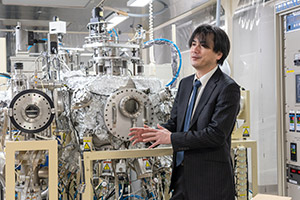

11/13/2023

In the quest for improved perpendicular magnetic tunnel junction (p-MTJ) devices for novel spintronic memory applications, scientists have been exploring novel materials and designs, blending theoretical predictions, spintronics principles, and iterative fabrication and characterization processes.
In their 2023 article, Suzuki and Mizukami from AIMR showcased progress using a tetragonal MnGa(001) ordered alloy thin film, aiming both to surpass the high tunnel magnetoresistance ratios (TMR) of established MgO barrier and FeCoB electrode-based p-MTJs, and to gain fresh insights for magnetic-device design1.
“Ordered Mn-alloy thin films, such as MnGa(001), are known to exhibit large perpendicular magnetic anisotropy (PMA) and low Gilbert damping2, and are predicted to yield high TMR p-MTJ devices3,” says Mizukami, the principal investigator. “Leveraging our experience in p-MTJ design4, we fabricated p-MTJs with a thin CoMn interlayer between the MgO barrier and the MnGa electrode, and a Mg ultrathin film between CoMn and MnGa.”
Combining magnetoresistance measurements with advanced structural-analysis techniques, including high-angle annular dark-field scanning transmission electron microscopy and energy-dispersive X-ray spectroscopy, the team observed a maximum enhanced TMR (> 100%) in the p-MTJs at the Mg thickness range of 0.4–0.5 nm, and the annealing temperature of 260 °C.
The team also observed a temperature-induced Mg migration away from the CoMn/MnGa interface which could correlate with TMR deterioration. These results suggest the presence of a Mg interlayer may help preserve the epitaxial growth of CoMn and MnGa, enhancing coherent tunneling.
Future directions will use the insights gained from MnGa(001) and Mg ultrathin films to explore the PMA of more intricate alloys, such as CoMnFe5.
(Author: Patrick Han)
This research highlight has been approved by the authors of the original article and all information and data contained within has been provided by said authors.